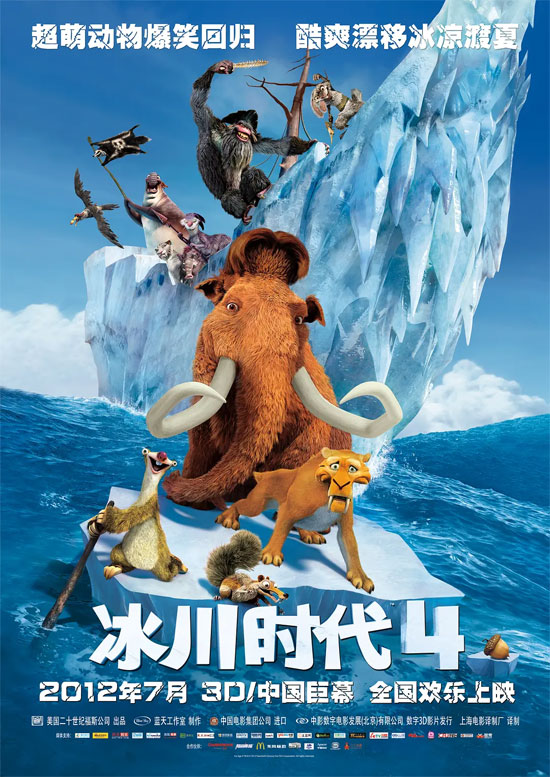Film Name: 冰川时代4 / Ice Age: Continental Drift

The charm of animation lies in constructing alternate worlds.
In this regard, Japanese animation excels at creating extraordinary systems of world rules; European animation excels at presenting worlds through unconventional symbols; while American animation excels at alienating the real world. Thus, in American animation—whether set in ancient times or the future, in the skies or the depths of the sea, and regardless of whether the protagonists are superheroes, robots, toys, cars, bees, monsters, fish, birds, or fluffy creatures—they all ultimately reflect contemporary American society, its social norms, and its values. No matter how fantastical American animation may seem, it ultimately rests firmly on an ethical foundation that respects family, teamwork, friendship, and individual independence, telling stories about freedom and equality.
Yet among them, the “Ice Age” series stands out as exceptionally distinctive. While it too inevitably falls into the “traps” of those universal values, its presentation carries a unique spirit—the shifting of symbolic signifiers. The driving force behind this spirit is: seeing the world through another lens, thinking about it with a different mindset.
The core of American animation’s alienated realism lies in constructing believability through brainstorming: what would happen if the familiar or classic elements of the real world were distorted?
For instance, in the “Cars” series, we encounter restrooms designed specifically for race cars, and in the sleek, dazzling Japanese night markets, neon advertisements related to automobiles are ubiquitous… These details of familiar objects build the credibility of a car-centric world. Though it still portrays real people and events, it makes you feel as if you’ve truly entered the realm of vehicles. Shrek’s parody is a classic example of alienating familiar tropes. It deconstructs classic fairy tales ingrained in everyone’s mind, making you laugh while reminding you that you’re in a monster’s aesthetic world. Yet it also constantly makes you feel an intrinsic connection between that world and the real one.
“Ice Age” also employs this technique of constructing credibility. First, in the details of alienating familiar objects, the pirates’ swords and guns become fish bones and conch shells—both historically accurate and visually evoking the familiar shapes of weapons. Second, in the alienation of classical elements, the squirrels’ utopian world is filled with reinterpretations of ancient Greek art, though shaped by the director’s imagination of how such classics might appear in a squirrel realm.
Yet another point I wish to highlight: when you see a massive iceberg plunge into water and float horizontally, it becomes the protagonists’ aircraft carrier; when a black-and-white weasel climbs to the pole’s summit and stretches, it transforms into a skull-patterned flag; when a squirrel is pinned to the ice by a fish clamped onto its tail, it unexpectedly morphs into a mermaid. you realize that “Ice Age” envisions the world far beyond the conventional American animation approach of using plausibility to de-mystify it. Instead, it reveals the multiple facets of the same object—viewed vertically, it’s a glacier’s edge; horizontally, an aircraft carrier; wrapped up, a skunk; laid flat, a flag; separated, a squirrel and a fish; combined, a mermaid.
This shifting of symbolic signifiers reveals the director’s dazzling imagination. This isn’t merely transferential thinking, but creative thinking; it doesn’t linger at the level of mere representation—though mastering that alone is already challenging—but ascends to a new height: using imagination to conduct a comprehensive, deep interpretation of an object or group of objects, especially uncovering the other side of things that people usually overlook. This, I believe, is one of the most commendable aspects of the “Ice Age” series.
Of course, the shifting of symbolic signifiers is merely a stylistic feature of “Ice Age,” not its soul. The film’s soul lies in its unique narrative jump structure and the radiance of humanity it embodies.
Speaking of narrative jumps, one cannot help but mention that irresistibly adorable little squirrel once more. Making this character—largely disconnected from the main narrative—the thread that weaves the plot together and serves as the mechanism for plot transitions is the series’ greatest creative stroke and most commendable innovation. The squirrel’s relentless pursuit of the acorn forms its own distinct storyline, harmonizing with the protagonists’ main narrative to create an incredibly engaging symphony.
Additionally, the film’s portrayal of ethical values is noteworthy. The message “Don’t change yourself for others” resonates deeply, as does the exploration of what constitutes a true family—is it the deceitful sloth clan, or the genuinely caring, misfit trio of mammoth, sloth, and saber-tooth tiger? The elderly, a vulnerable group in society, demonstrate their profound significance within the film. The humble mole reveals its greatest strength—not in physical might, but in possessing a courageous heart that cherishes friendship above all.
Please specify:Anime Phone Cases » Ice Age: Continental Drift 2012 Animation Film Review: Symbolic Call Forwarding